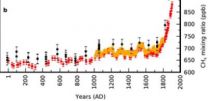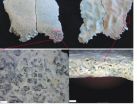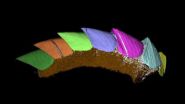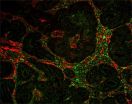(Press-News.org) PHILADELPHIA – LAM, short for pulmonary lymphangioleiomyomatosis, affects about 1 in 10,000 women of childbearing age and is characterized by proliferation of smooth muscle-like cells in the lung, destruction of lung tissue, and growth of lymphatic vessels. The disease manifests itself in a wide variety of ways, so it is sometimes difficult to diagnose and there is no cure. The disease is caused by inactivation of either of two genes, TSC1 or TSC2, but to date no animal model has been able to replicate the pathologic features those mutations produce in humans.
Now, researchers at the Perelman School of Medicine at the University of Pennsylvania report in Science Translational Medicine a new mouse model of LAM that does replicate those features, producing a way to study disease etiology and develop drugs. What's more, two readily available drugs – an antibiotic and a statin – may help to treat, and maybe reverse, symptoms.
Elena Goncharova, PhD, research assistant professor of Medicine, and Vera Krymskaya, PhD, associate professor of Medicine, Pulmonary, Allergy, and Critical Care Division at Penn, led the study. The team collected TSC2-mutant cells from spontaneous kidney tumors formed in mice. They then "sensitized" those cells by growing them into tumors in immunocompromised mice, excising those tumors, and reinjecting their cells into the tail veins of another set of immunocompromised mice.
Unlike non-sensitized TSC2-deficient cells, the sensitized cells produced multiple lung nodules comprised of smooth muscle-like cells, as in the human disease, as well as destruction of lung tissue and lymphangiogenesis. These nodules also exhibited enhanced activity of an enzyme called matrix metalloproteinase and the loss of elastin, suggesting a potential mechanism for causing that tissue damage. The study also demonstrated for the first time that destruction of lung tissue in LAM is caused by TSC2 deficiency in lung lesions.
TSC1 and TSC2 regulate the mTOR (mammalian target of rapamycin) pathway. As a result, the antibiotic rapamycin is already used therapeutically for pulmonary LAM. But, says Goncharova, the drug appears only to halt cell growth, not induce cell death. When rapamycin is removed, disease progresses. "That showed us that something else was needed to fully treat the disease," she says.
As it turns out, that something else could be a statin.
Statins are well known cholesterol-controlling medications. But they also can inhibit signaling proteins called GTPases, inducing cell death. An earlier study using rapamycin and simvastatin demonstrated that the combination could prevent tumor reoccurrence in a mouse model in which TSC2-mutant tumors were not grown in the lungs, but in the flanks of the animal.
The current study expands that observation, demonstrating that rapamycin plus simvastatin can inhibit the growth of TSC2-mutant tumors in the mouse lung, as well as the resulting tissue damage.
But perhaps more importantly, from a clinical point-of-view, application of the drugs after development of lung nodules and tissue damage could actually reverse tissue damage.
"It's my strong belief that if you want to propose treatment options, you need to reverse or attenuate existing disease. Prevention is not enough," says Goncharova.
As in the earlier study, rapamycin in this study appears to be cytostatic – it halts cell growth; simvastatin induces cell death, and both drugs block matrix metalloproteinases as well. Both drugs are FDA-approved and commercially available.
But before pulmonary LAM patients call their physicians for a prescription, Goncharova stresses that the results were in mice, not humans. Clinical trials are required to test the efficacy of this drug combination in patients. To date, no such trials have been initiated.
"I hope it will be done in the near future," she says.
###
Other co-authors from Penn include Dmitry Goncharov, Melane Fehrenbach, Irene Khavin, Blerina Ducka, Angela Haczku, and Steven Albelda.
The study was supported by the National Heart, Lung, and Blood Institute (RO1HL71106, RO1HL090829, RO1HL114085), Abramson Cancer Center Core Support Grant (NIH P130-CA-016520-34, P30ES013508, RO1AI072197, RC1ES018505), the American Lung Association (CI-9813-N), the LAM Foundation, and the Auckland Medical Research Foundation.
Penn Medicine is one of the world's leading academic medical centers, dedicated to the related missions of medical education, biomedical research, and excellence in patient care. Penn Medicine consists of the Raymond and Ruth Perelman School of Medicine at the University of Pennsylvania (founded in 1765 as the nation's first medical school) and the University of Pennsylvania Health System, which together form a $4.3 billion enterprise.
The Perelman School of Medicine is currently ranked #2 in U.S. News & World Report's survey of research-oriented medical schools. The School is consistently among the nation's top recipients of funding from the National Institutes of Health, with $479.3 million awarded in the 2011 fiscal year.
The University of Pennsylvania Health System's patient care facilities include: The Hospital of the University of Pennsylvania -- recognized as one of the nation's top "Honor Roll" hospitals by U.S. News & World Report; Penn Presbyterian Medical Center; and Pennsylvania Hospital — the nation's first hospital, founded in 1751. Penn Medicine also includes additional patient care facilities and services throughout the Philadelphia region.
Penn Medicine is committed to improving lives and health through a variety of community-based programs and activities. In fiscal year 2011, Penn Medicine provided $854 million to benefit our community.
Penn-developed mouse model of debilitating lung disease suggests potential treatment regimen
2012-10-04
ELSE PRESS RELEASES FROM THIS DATE:
Mom's high blood pressure in pregnancy could affect child's IQ in old age
2012-10-04
New research from the University of Helsinki, Finland, suggests that a mother's high blood pressure during pregnancy may have an effect on her child's thinking skills all the way into old age. The study is published in the October 3, 2012, online issue of Neurology®, the medical journal of the American Academy of Neurology.
"High blood pressure and related conditions such as preeclampsia complicate about 10 percent of all pregnancies and can affect a baby's environment in the womb," said study author Katri Räikkönen, PhD. "Our study suggests that even declines in thinking ...
Methane emissions can be traced back to Roman times
2012-10-04
Emissions of the greenhouse gas methane into the atmosphere can be traced back thousands of years in the Greenland ice sheet. Using special analytical methods, researchers from the Niels Bohr Institute, among others, have determined how much methane originates from natural sources and how much is due to human activity. The results go all the way back to Roman times and up to the present, where more than half of the emissions are now man-made. The results are published in the scientific journal, Nature.
Methane is an important greenhouse gas, which today is partly emitted ...
Surprising black-hole discovery changes picture of globular star clusters
2012-10-04
An unexpected discovery by astronomers using the National Science Foundation's Karl G. Jansky Very Large Array (VLA) is forcing scientists to rethink their understanding of the environment in globular star clusters, tight-knit collections containing hundreds of thousands of stars.
The astronomers used the VLA to study a globular cluster called Messier 22 (M22), a group of stars more than 10,000 light-years from Earth. They hoped to find evidence for a rare type of black hole in the cluster's center. They wanted to find what scientists call an intermediate-mass black hole, ...
50-hour whole genome sequencing provides rapid diagnosis for children with genetic disorders
2012-10-04
KANSAS CITY, Mo. – OCTOBER 3, 2012 – Today investigators at Children's Mercy Hospitals and Clinics in Kansas City reported the first use of whole genome information for diagnosing critically ill infants. As reported in Science Translational Medicine, the team describes STAT-Seq, a whole genome sequencing approach - from blood sample to returning results to a physician - in about 50 hours. Currently, testing even a single gene takes six weeks or more.
Speed of diagnosis is most critical in acute care situations, as in a neonatal intensive care unit (NICU), where medical ...
Key environmental factors influencing manta ray behavior identified
2012-10-04
Manta rays are more likely to gather together under either a new or a full moon, according to new research published Oct 3 in the open access journal PLOS ONE by Fabrice Jaine and colleagues at the University of Queensland.
The research identifies environmental factors that predict the abundance and behavior of manta rays at Lady Elliott Island in the Great Barrier Reef. The authors comment that knowing these factors is important for conservation efforts, "especially in the context of a changing climate and with targeted fisheries increasingly threatening manta ray populations ...
Oldest evidence of regular meat consumption by early humans found
2012-10-04
A fragment of a child's skull discovered at Olduvai Gorge, Tanzania shows the oldest known evidence of anemia caused by a nutritional deficiency, reports a new paper published Oct. 3 in the open access journal PLOS ONE.
The discovery, made by a global team of researchers led by Manuel Domínguez-Rodrigo from Complutense University, Madrid, suggests that early human ancestors began eating meat much earlier in history than previously believed. The skull fragment identified is thought to belong to a child somewhat younger than two and shows bone lesions that commonly result ...
Novel blood-based protein signature determined for rare, aggressive lung cancer
2012-10-04
Researchers have discovered a panel of 13 blood proteins that may be effective biomarkers to detect malignant mesothelioma, according to a study published Oct. 3 in the open access journal PLOS ONE by Rachel Ostroff from the company SomaLogic, which developed the new test, and colleagues at other institutions.
Malignant mesothelioma is a rare, aggressive form of lung cancer that can develop after prolonged exposure to asbestos. Because early diagnosis is difficult, most patients face a poor prognosis and have few options for treatment. In the study, authors compared proteins ...
Less is more when choosing between groups of assorted items
2012-10-04
When making decisions about the value of an assortment of different objects, people approximate an average overall value, which though frequently useful can lead to apparently irrational decision-making. A new study published Oct 3 in PLOS ONE by Jerald Kralik and colleagues at Dartmouth College shows for the first time that non-human primates also make similar 'irrational' choices based on approximation.
In the study, researchers found that rhesus monkeys preferred a highly-valued food item (a fruit) alone to the identical item paired with a food of positive but lower ...
Mollusc missing link revealed in 3-D
2012-10-04
Scientists have discovered a rare fossil called Kulindroplax, the missing link between two mollusc groups, which is revealed in a 3D computer model, in research published today in the journal Nature.
The researchers have unearthed the worm-like partly shelled Kulindroplax, which they have modelled in a 3D computer animation. Kulindroplax lived in the sea during the Silurian Period, approximately 425 million years ago, when most life lived in the oceans and the first plants were beginning to grow on land. The team found the Kulindroplax fossil, the only one of its kind ...
Blocking tumor-induced inflammation impacts cancer development
2012-10-04
Researchers at the University of California, San Diego School of Medicine report the discovery of microbial–dependent mechanisms through which some cancers mount an inflammatory response that fuels their development and growth.
The findings are published in the October 3, 2012 Advanced Online Edition of Nature.
The association between chronic inflammation and tumor development has long been known from the early work of German pathologist Rudolph Virchow. Harvard University pathologist Harold Dvorak later compared tumors with "wounds that never heal," noting the similarities ...





